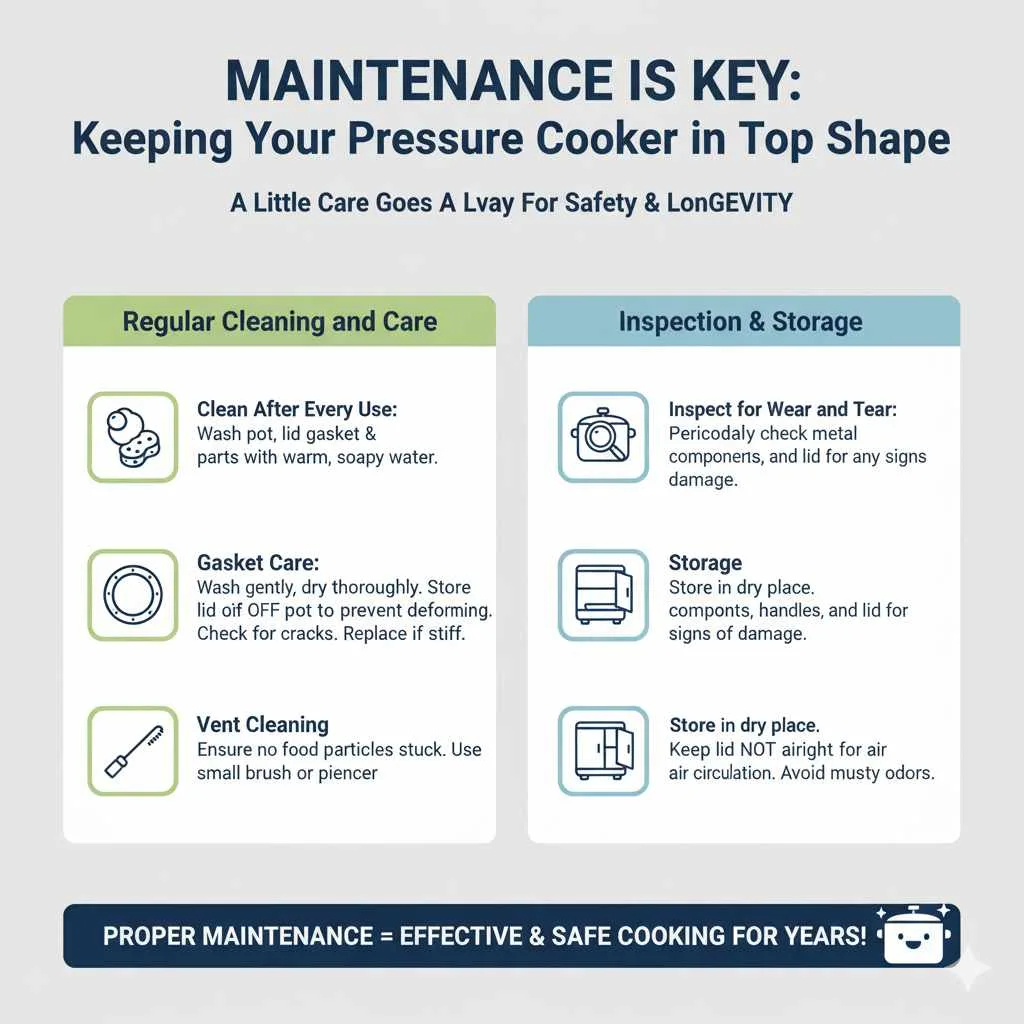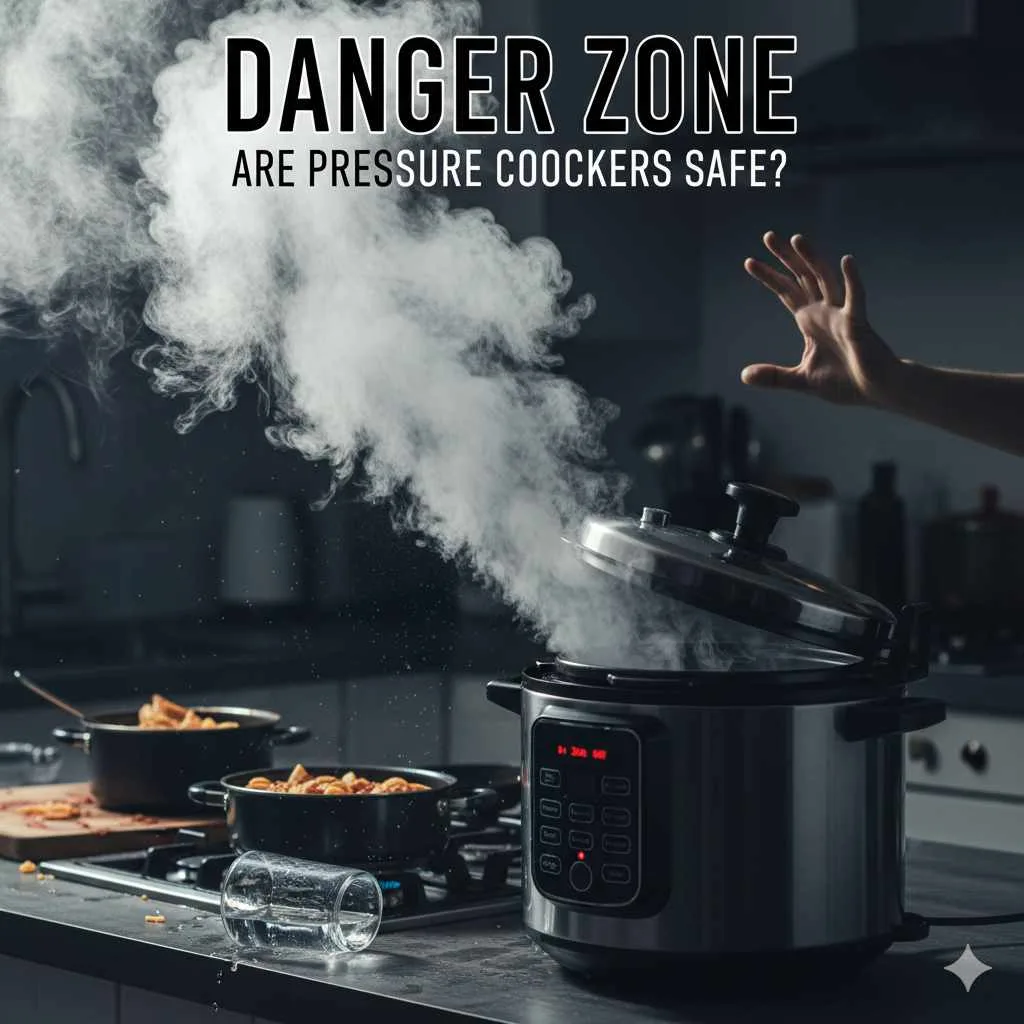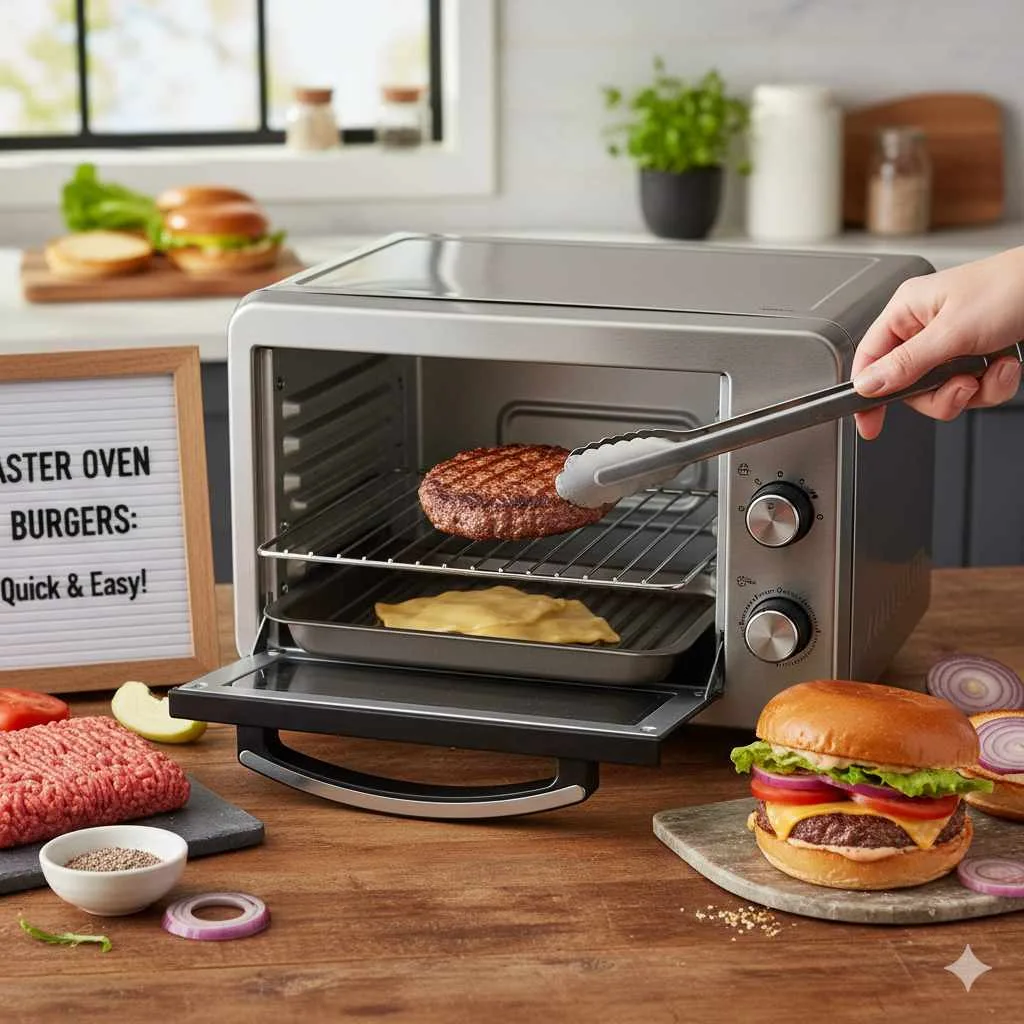Quick Summary:
Pressure cookers are incredibly safe when used correctly. Modern designs have multiple safety features, making the risk of danger extremely low. Following essential safety guidelines ensures you can enjoy quick, delicious meals with complete peace of mind.
Hello, lovely home makers! Arlene here. Have you ever looked at that shiny pot with all the valves and wondered, “Are pressure cookers dangerous?” It’s a question many of us have pondered. These kitchen powerhouses promise faster cooking and amazing flavors, but that little voice of concern can sometimes hold us back from exploring their potential. Don’t let that happen! Using a pressure cooker is actually quite straightforward and, with a few simple tips, wonderfully safe. We’re going to walk through everything you need to know to use your pressure cooker confidently and discover the magic it can add to your kitchen. Ready to unlock some serious cooking convenience?
Unpacking the Pressure Cooker: Myth vs. Reality
The image of a pressure cooker exploding might be etched in our minds from old movies or cautionary tales. It’s understandable why some beginners might feel a little intimidated. However, it’s crucial to understand that those older, stovetop models were different. Today’s pressure cookers, whether stovetop or electric, are marvels of modern engineering designed with multiple layers of safety. Think of them less as ticking time bombs and more as highly controlled cooking vessels.
The primary function of a pressure cooker is to cook food faster by increasing the boiling point of water. When liquid is heated in a sealed pot, the trapped steam builds up pressure. This pressure raises the temperature of the steam and liquid well above normal boiling point (100°C or 212°F). For instance, at 15 psi (pounds per square inch) above atmospheric pressure, water boils at about 121°C (250°F). This higher temperature dramatically speeds up the cooking process. The safety mechanisms are designed to ensure this pressure is precisely controlled, never reaching dangerous levels.
How Does a Pressure Cooker Work Safely?
The magic of pressure cooking lies in harnessing steam. Here’s a simplified breakdown:
- Sealing the Pot: A lid with a gasket creates an airtight seal.
- Heating the Liquid: When heated, the liquid turns into steam.
- Building Pressure: The trapped steam increases the internal pressure.
- Raising Temperature: This pressure elevates the cooking temperature significantly.
- Safety Valves: Crucial components release excess steam if pressure gets too high, preventing over-pressurization.

Key Safety Features You’ll Find on Modern Pressure Cookers
Modern pressure cookers are designed with your safety as the top priority. Manufacturers have incorporated several ingenious features to prevent mishaps. Understanding these will boost your confidence immensely.
The Essential Safety Components
- The Locking Lid: Most pressure cookers have a lid that cannot be opened while the pot is under pressure. This is a fundamental safety feature. You’ll often hear a click or feel a resistance when trying to open it prematurely.
- Primary Pressure Regulator/Vent: This is the part that usually whistles or releases steam to maintain the correct cooking pressure. It’s designed to vent excess steam automatically if the pressure exceeds the set limit.
- Overpressure Plug/Release Valve: This is a backup safety device. If the primary regulator fails or gets blocked, this plug is designed to melt or pop out, releasing pressure quickly and safely.
- Safety Vent Tube: Some models have an extra tube that directs steam away from the user.
- Safety Locking Pin: Many electric pressure cookers have a pin that rises when the pot is pressurized and prevents the lid from being opened.
These features work in harmony to ensure that the pressure inside your cooker never reaches a dangerous level. It’s like having a team of tiny safety guardians watching over your meal!
Before You Even Turn On the Heat: Essential Pre-Cooking Checks
Just like any kitchen tool, proper preparation is key to safe and successful use. Taking a few moments before you start cooking can prevent potential issues and ensure your meal turns out perfectly.
Step-by-Step Pre-Cooking Safety Checklist
- Read Your Manual: Yes, that slightly intimidating booklet! Every pressure cooker is a little different. Your manual is the ultimate guide to your specific model’s features, operation, and care. Don’t skip this step! You can often find digital copies on the manufacturer’s website if you’ve misplaced yours.
- Inspect Gasket and Valves: Ensure the rubber or silicone sealing ring (gasket) is clean, free of cracks, and properly seated in the lid. Check that all the steam vents and valves are clear of any food debris. A blocked valve is the most common reason for pressure build-up concerns.
- Check for Damage: Look for any dents, cracks, or warping on the pot, lid, or handles. If you find any damage, it’s best not to use the cooker until it’s inspected or repaired by a professional.
- Add Enough Liquid: Pressure cookers require a minimum amount of liquid to generate steam. This is usually specified in your manual (often 1 to 2 cups). Never use less than the recommended amount.
- Don’t Overfill: There’s a maximum fill line inside your pressure cooker, usually marked. Never fill it more than two-thirds full (or half full for foods that expand, like beans or grains). Overfilling can block the steam vents.
- Ensure the Lid is Locked: Before bringing it up to pressure, make sure the lid is correctly positioned and locked securely.
These simple checks take only a minute or two but make a world of difference in ensuring safe operation. Think of it as your daily warm-up routine for your pressure cooker!
Operating Your Pressure Cooker Safely: During the Cook
Now that you’ve done your pre-cooking checks, it’s time to get cooking! The process of building pressure and cooking is where most people wonder about safety. Here’s how to manage it with confidence.
Building Pressure and Cooking
- Start Heating: Place your pressure cooker on the stove over the recommended heat setting (usually medium-high) or select the appropriate setting on your electric model.
- Watch for Pressure: For stovetop models, you’ll start seeing steam escaping from the vent whistle or indicator. Once pressure is reached, the regulator will start to function (e.g., whistle, rock, or vent).
- Adjust Heat: Once the cooker reaches pressure, immediately reduce the heat to the lowest setting that maintains pressure. You want to hear just a gentle hiss or click, not a continuous, loud steam release. This is crucial for consistent cooking and safety. Too high a heat can cause food to scorch and could potentially overload safety valves.
- Start Timing: Begin timing your recipe once the correct pressure is achieved and maintained.
- Monitor Occasionally: While you don’t need to hover, it’s wise to briefly check the cooker every so often on the stovetop. Listen for any unusual noises or excessive steam release. For electric models, the display will indicate pressure status, and they are designed to manage this automatically.
Remember, the goal is to maintain a steady, controlled pressure. This is what allows for quick and efficient cooking without compromising safety.
“Houston, We Have a Problem?”: What to Do if Something Seems Off
Even with the best intentions, sometimes things don’t go exactly as planned. Knowing what to do if you suspect an issue with your pressure cooker can prevent a minor hiccup from becoming a concern.
Troubleshooting and Immediate Actions
- Too Much Steam Escaping: If you have excessive steam continuously venting from the primary regulator (not just a gentle hiss or occasional puff), turn off the heat immediately. Let the pressure release naturally. Once it’s safe to open, check if the vent is blocked by food particles. If so, clean it thoroughly before re-using.
- No Steam is Building: If after a reasonable time (e.g., 10-15 minutes on high heat for stovetop models) no steam is appearing, turn off the heat. Check:
- Is there enough liquid in the pot?Is the lid sealed properly?Is the vent regulator blocked? Address any issues and try again.
- Lid Won’t Open: This is a sign that there is still pressure inside. NEVER force the lid. Wait for the pressure to release completely. Modern electric cookers have visual indicators for pressure. Stovetop models will stop releasing steam when pressure is gone. You can also use the quick-release method (see below) if you need to speed up depressurization.
- Unusual Noises: While some noises are normal (like whistling or hissing), loud banging or sputtering could indicate an issue. Turn off the heat and let it cool down to assess.
The most important rule is: When in doubt, turn off the heat and let the pressure release naturally. Your safety is paramount.
Safe Methods for Releasing Pressure
Once your cooking time is up, you need to let the pressure out before opening the lid. There are generally three ways to do this, and using the correct method is vital.
Understanding Pressure Release Options
- Natural Release (NR): This is the gentlest method. Simply turn off the heat (or stop the cooking cycle) and let the pressure dissipate on its own. It can take anywhere from 10 to 30 minutes, depending on the amount of liquid and food. This is often recommended for meats and dishes that benefit from resting, as it helps retain moisture and tenderness.
- Quick Release (QR): This is done by manually opening the steam release valve or vent. Use tongs or an oven mitt to carefully turn the valve or push the quick-release button. A strong jet of steam will be released. Always direct the steam away from your face, body, cabinets, and light fixtures. This method is faster than natural release and suitable for vegetables or when you need to stop the cooking process immediately.
- Cold Water Release (for some stovetop models ONLY): Some older stovetop models allow you to run cold water over the lid (avoiding the valve). This rapidly cools the pot and lowers the pressure. Check your manual to see if this method is safe for your cooker, as it can damage some gaskets or electric models.
Important Note: Always ensure the pressure has fully released before attempting to open the lid. Many cookers have a float valve or pin that drops down when it’s safe to open.
Pressure Cooker vs. Air Fryer vs. Instant Pot: A Quick Comparison
Many modern kitchens have a variety of countertop appliances. While you might be thinking about pressure cookers, it’s helpful to see how they fit into the picture, especially with the popularity of electric multi-cookers like the Instant Pot, which often combine pressure cooking and air frying.
| Appliance Type | Primary Function | Pros | Cons | Best For |
|---|---|---|---|---|
| Traditional Stovetop Pressure Cooker | Cooking under high pressure using steam. | Very fast, energy-efficient, durable, often more affordable. | Requires active monitoring on the stovetop, manual pressure release. | Soups, stews, beans, tough cuts of meat, grains. |
| Electric Pressure Cooker (e.g., Instant Pot Lid models) | Controlled high-pressure cooking via electricity. | Set-it-and-forget-it convenience, programmable, often multi-functional (slow cook, sauté, etc.). | Can be more expensive, takes up counter space, may require specific accessories. | Similar to stovetop but with more programming options. Ideal for busy individuals. |
| Air Fryer | Circulating hot air to “fry” food with little to no oil. | Crispy textures, healthy alternative to deep frying, fast cooking for small batches. | Limited capacity, not ideal for very large items or liquids. | Fries, chicken wings, roasted vegetables, reheating crispy foods. |
| Multi-Cooker (e.g., Instant Pot with Pressure Cook & Air Fry Lids) | Combines multiple cooking functions, including pressure cooking and air frying. | Versatile, saves counter space by combining appliances, convenient. | Can be costly, may have separate lids for different functions, requires learning multiple modes. | A wide range of dishes, from tender meats (pressure cook) to crispy snacks (air fry). Great for small kitchens. |
Multi-cookers that include pressure cooking are extremely popular because they offer the speed of pressure cooking alongside other functions. While the principles of pressure cooking remain the same, the user interface and some safety locks might differ slightly between standalone electric pressure cookers and multi-cookers that also air fry. Always refer to the specific manual for your appliance.
Maintenance is Key: Keeping Your Pressure Cooker in Top Shape
Just like any well-loved kitchen tool, your pressure cooker will perform best and stay safest when it’s properly maintained. A little care goes a long way.
Regular Cleaning and Care
- Clean After Every Use: Wash the pot, lid, gasket, and any removable parts with warm, soapy water. Use a soft brush or sponge.
- Gasket Care: The sealing ring is crucial. Wash it gently and dry it thoroughly. Some people prefer to store the lid off the pot to prevent the gasket from deforming. Check it regularly for cracks or stiffness. Replacement is usually straightforward. A good resource for understanding gasket care can be found on sites like FoodSafety.gov, which offers general guidance on safe kitchen practices.
- Vent Cleaning: Ensure no food particles are stuck in the vent openings. You might need a small brush or pipe cleaner for this.
- Inspect for Wear and Tear: Periodically check the metal components, handles, and lid for any signs of damage.
- Storage: Store your pressure cooker in a dry place. Ensure the lid is not airtight to allow air circulation, which can prevent musty odors.
Proper maintenance ensures your pressure cooker functions effectively and safely for years. Think of it as giving your favorite cooking buddy a good spa treatment!

Frequently Asked Questions About Pressure Cooker Safety
Are pressure cookers safe for beginners?
Absolutely! Modern pressure cookers are designed with numerous safety features, making them very safe for beginners when used according to the manufacturer’s instructions. The key is to follow the manual and our safety tips.
Can a pressure cooker explode?
While the risk is extremely low with modern, well-maintained pressure cookers, older models or units used improperly (e.g., blocked vents, damaged parts) could pose a risk. Today’s cookers have multiple safety release systems to prevent dangerous over-pressurization.
What should I do if I smell burning?
Immediately turn off the heat and let the pressure release naturally. Once it’s safe to open, inspect the pot. There might be insufficient liquid, food particles stuck to the bottom, or the heat might have been too high, causing scorching. Clean thoroughly before reuse.
How do I know if my pressure cooker is still under pressure?
Most electric models have a visual indicator (a float valve or pin) that remains raised when under pressure and drops down when it’s safe to open. For stovetop models, the steam vent will stop releasing steam, and the pressure indicator will drop. Never try to force the lid open.
Is it safe to leave a pressure cooker unattended on the stove?
For stovetop models, it’s generally recommended to stay nearby and monitor them, especially when you are new to using them. Electric pressure cookers are designed for unattended operation once set, as they have automatic controls.
Can any pot be used as a pressure cooker?
No. Pressure cookers are specifically designed with reinforced lids, locking mechanisms, and safety valves to withstand and control high internal pressure. Standard pots and lids are not built for this and can be very dangerous.
Conclusion
You’ve now got a comprehensive understanding of how pressure cookers work and, most importantly, how to use them safely. It’s clear that with a little knowledge and adherence to simple guidelines, these appliances are not dangerous but rather incredibly beneficial tools for any kitchen.
From tenderizing tough cuts of meat in a fraction of the time to cooking dried beans without soaking, pressure cookers open up a world of culinary possibilities. They lock in flavor and nutrients, thanks to the quick cooking times, making them a fantastic option for healthy eating. And let’s not forget








Leave a Reply